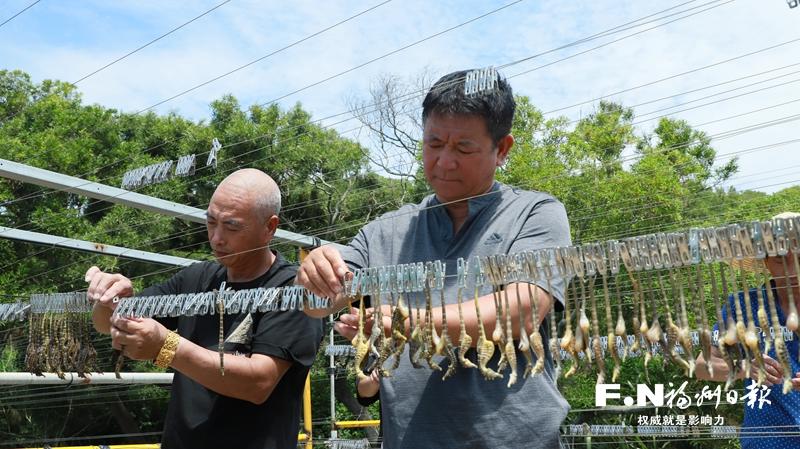12 Million Seahorses from Lianjiang Hit the Market
After 8 months of meticulous cultivation
12 million seahorses from Lianjiang have been introduced to the market
On June 10, the reporter learned that after eight months of cultivation, 12 million seahorses raised in insulated greenhouses by fishermen along the Lianjiang coast have reached marketable size. In recent days, local fishermen seized the good weather to catch and dry the seahorses, preparing them for sale in the market.

Lianjiang fishermen seized the clear weather to dry the seahorses. (Photo courtesy of Lian Rongmei)
Seahorses are valuable marine drug-derived organisms, rich in proteins, amino acids, and fatty acids, often referred to as the “Southern Ginseng.” In recent years, the global population of wild seahorses has sharply declined, leading to their classification as an endangered species internationally. In China, wild seahorses are also listed as National Second-Class Protected Wildlife. Due to the technical challenges of seahorse farming, offshore aquaculture remains unfeasible. In response, pioneering fishermen in Lianjiang have turned to land-based, factory farming to cultivate seahorses.
On June 10, the reporter visited the seahorse farming base in Dinghai Village, Xiaocheng Town, Lianjiang County. Inside the black insulated greenhouses, rows of aquaculture tanks, each about 60 square meters in size, were neatly arranged. The seahorses alternated between swimming gracefully, their bodies stretched taut, and resting upside down on cylindrical plastic frames. Some even wrapped their tails around the filter nets on the climbing frames, remaining completely still.
“We raise big-belly seahorses (Hippocampus abdominalis), which are extremely sensitive to water quality, temperature, light, bait, and other external environment factors. Even the smallest mistake can cause problems. It's more demanding than caring for a child. In the first few months, we practically lived in the greenhouse,” said Lin Jianhua, a technician at the seahorse farming base.
Taking advantage of the seahorses’ habit of resting upside down, the workers lift the frames from the water and gently shake them up and down. The mature seahorses, each about 8 to 9 centimeters long, fall off the frames and drop into the baskets. In less than 30 seconds, the basket is full.
Once the seahorses are caught, the fishermen immediately rinse them with fresh water. They then bring them to the rooftop, where each seahorse is carefully straightened. Using stainless steel clips, they attach the seahorses to iron wires and hang them upside down to dry and set for two hours. After shaping, the seahorses are placed on bamboo racks to dry for an additional three days. This drying process gives the seahorses an attractive appearance, which is highly favored in the market.
An official from the Lianjiang County Bureau of Ocean and Fisheries stated that more than 12 million seahorse seedlings were released last October. After eight months of farming, they have now grown to marketable size, with each seahorse weighing an average of 6 grams.
“Seahorses have significant medicinal and economic value, with vast market potential. Dried seahorses are priced between 3,000 and 7,000 yuan per kilogram, with larger ones commanding a premium,” said Wei Xinhua, head of the seahorse farming base. The base is currently raising 5 million seahorses, keeping a small portion for breeding and selling the rest, primarily to pharmaceutical companies.
According to the information, seahorses are the only animals on Earth where the males give birth. A single male can deliver hundreds or even thousands of young at once. The male seahorse has a brood pouch on its front or side, which functions like a “maternity pouch,” making it easy to tell the males from the females when buying them. (Fuzhou Daily Reporter: Lin Wenjing; Correspondents: Wu Qifa and Qiu Censhu)